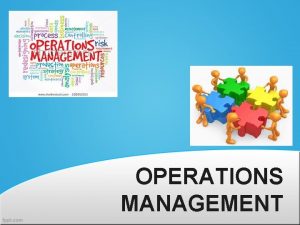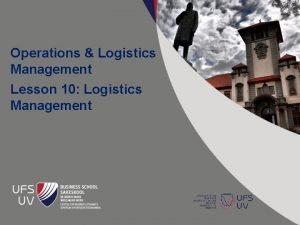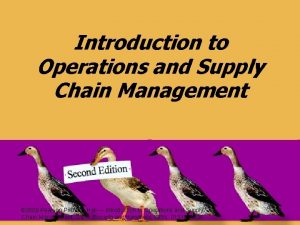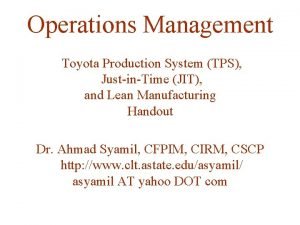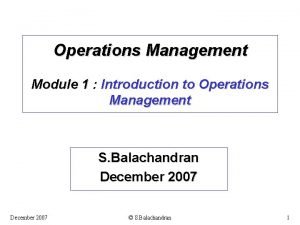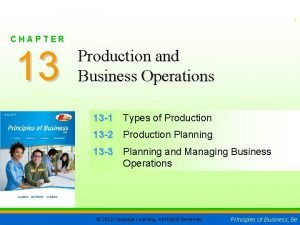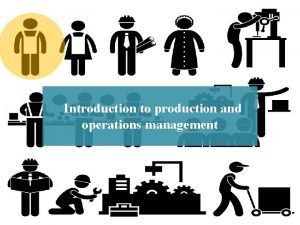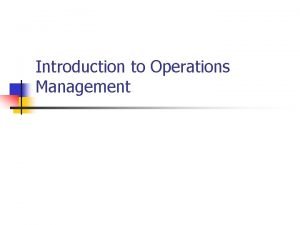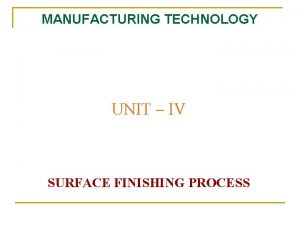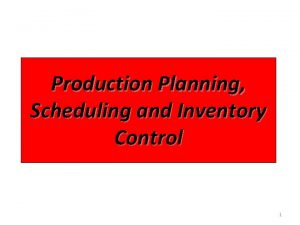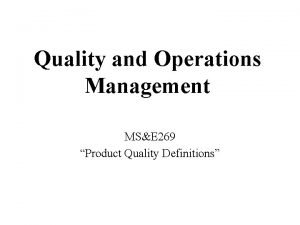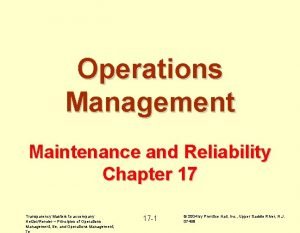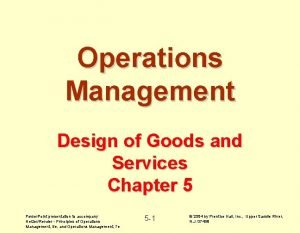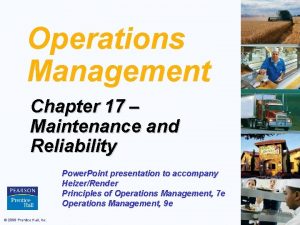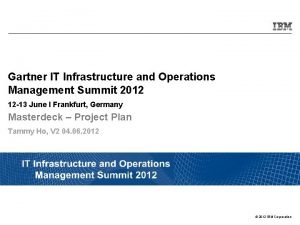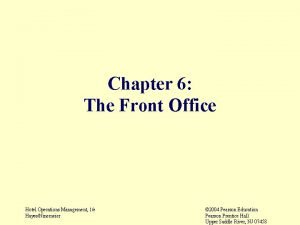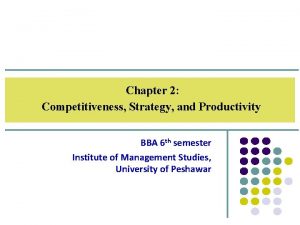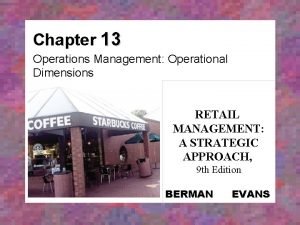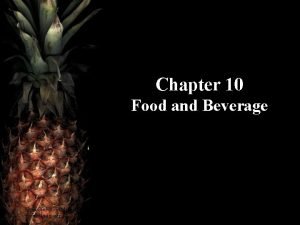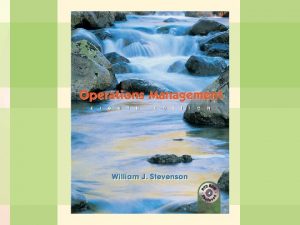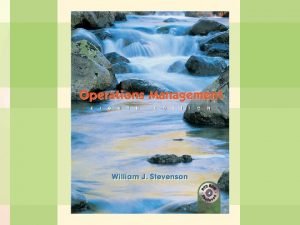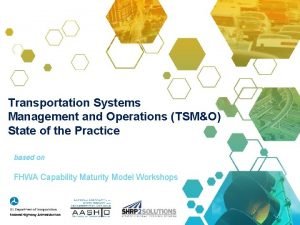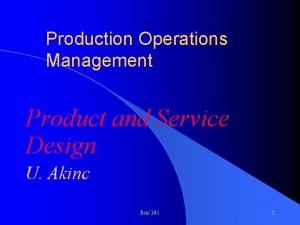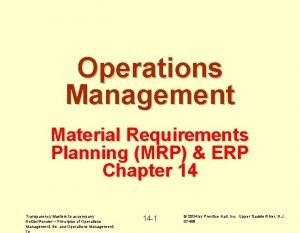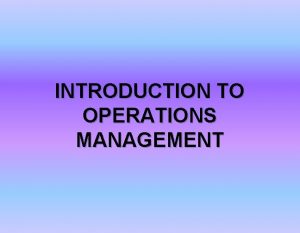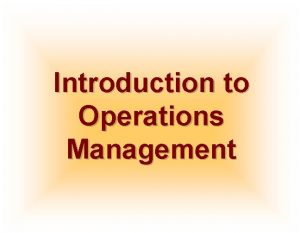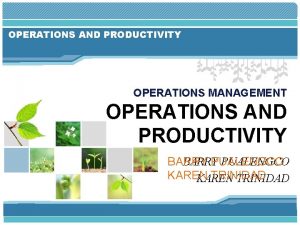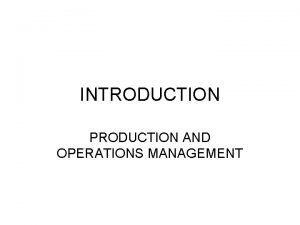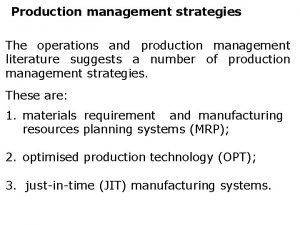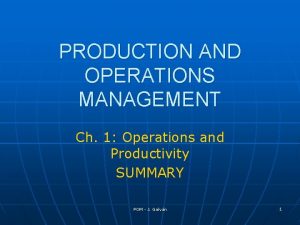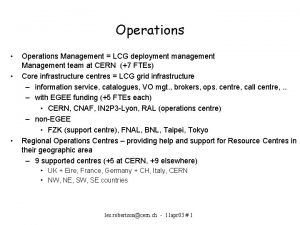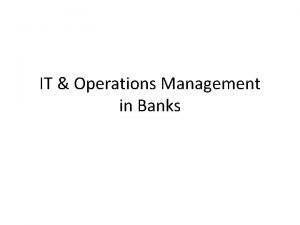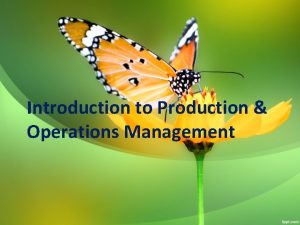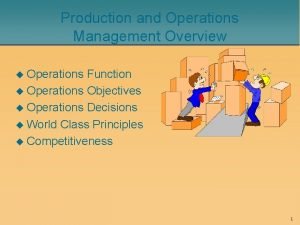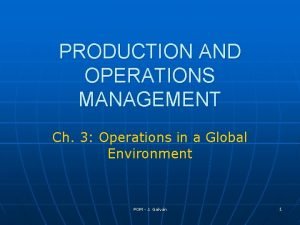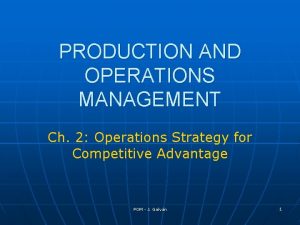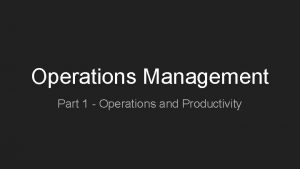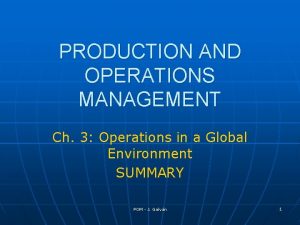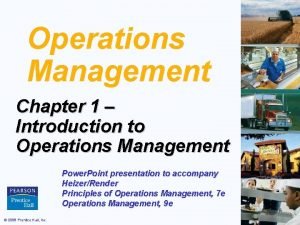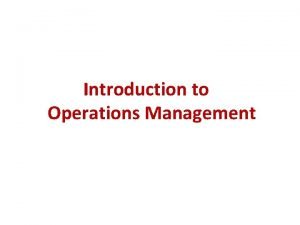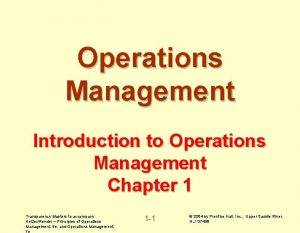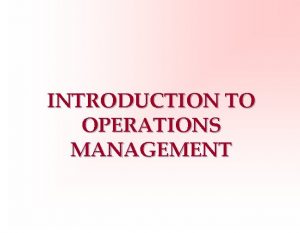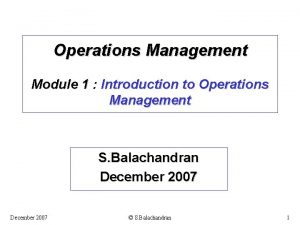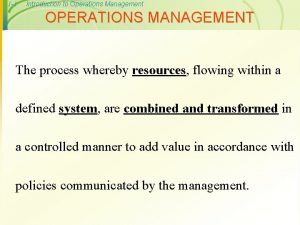PRODUCTION AND OPERATIONS MANAGEMENT 1 Introduction to Production

































- Slides: 33

PRODUCTION AND OPERATIONS MANAGEMENT 1

Introduction to Production Function and Operations Management Mass Production Approach Toyota Production System (TPS) Approach Supply Chain Management 2

Some Questions What does your Firm ACTUALLY do? How does it work? Do it MAKE or ASSEMBLE something? Is there a Difference? So What? How do you decide How to do something? 3

Theory of Firm Growth and Optimal Organization Size TOTAL EXPENSES Direct (Variable) and Indirect (Fixed/Overhea d) HIGH Unprofitabl e C A B LOW Profitable STRATEGIC CHOICE Maintain Size and Decrease Expenses or… Consider Optimal Size FEW Market MOST Internal FIRM SIZE Controlled Resources 4

PRODUCTION vs. MANUFACTURING v Production is a Broader Term that Spans both Manufacturing and Services Functions v Applies Resources, People and Machinery, to Convert Inputs into Finished Goods and Services 5

MASS PRODUCTION Mass Production: Makes Outputs available in Large Quantities at Lower Unit Costs than Individually-Crafted Items Characteristics of Mass Production Labor Specialization Mechanization Standardization 6

ASSEMBLY LINES Assembly Line first Introduced by Eli Whitney (Cotton Gin Inventor) to build Muskets for the US Government in 1799 Used Ideas of Specialized Labor and Engineering Standards (Tolerances) to produce Assemblies from Parts in Repeatable Sequence 7

HENRY FORD Moving Assembly Line: Dramatically Reduced Manufacturing Costs While Delivering Consistent, Low-Priced Product Factory based on Chicago Meat Cutting Plants 8

FORD MODEL “T” First Produced: Oct. 1908 By 1927, 15, 000 Produced Any Color if it’s Black… 2004 EPA All Vehicles Average: 21 MPG Model “T” Fuel Economy: 25 MPG 9

ASSEMBLY LINE BENEFITS Initially, took 14 hours to Assemble Model T - Mass Production reduced Time to 1 Hour and 33 Minutes Model T’s Price dropped from $1, 000 in 1908 to $360 in 1916 Result was Ford became Dominant Automobile Manufacturer and Assembly Line Method as Dominant 10

FORD ASSEMBLY LINES Assembly Line pulled by Ropes Magneto Assembly 11

MASS PRODUCTION MODEL “T” – The Machine that Changed the World 1914: Ford produced 308, 162 cars, more than all 299 other auto manufacturers combined 1927: Automobile Produced every 24 Lower seconds. Higher Costs Volumes Lower Prices Increased Sales 12

MASS PRODUCTION “PUSH” Strategy – Driven by Inputs and Objectives Control of Raw Materials and Labor plus Profit Goals = Production Rate separate from Customer Demands and Preferences Performance measured by Budget Variances and Quantitative Results (Defects or Unit Costs per Day, Week or 13

MASS PRODUCTION « Low Product Variety; Small Orders Not Feasible « Specialized Machinery and Centralized Manufacturing « “Economies of Scale” – High-Speed Sequential Production « Development Costs Spread Over Large Volume: Low Cost per Unit Produced « Low-Skill/Low-Wage Work Force « Large Advertising and Marketing 14 Budgets

FORD WORKING CONDITIONS Assembly Line Work Monotony: 300% Turnover « $2 per Day and a 9 -Hour Shift Ford’s Response to Working Conditions: « Increased Pay to $5 per Day and Reduced Shifts from 9 Hours to 8 Hours “The Chain System you have is a Slave Driver. My God, Mr. Ford! My Husband has come Home and Thrown Himself Down and won’t Eat his Supper, He’s so done out. Can’t it be Remedied? That $5 -a-day is a Blessing; a Bigger One than you Know. But, Oh, They Earn It!” 15 - Wife of Ford Assembly Line Worker

MASS PRODUCTION Flaws of Mass Production Approach ³ Production Levels cannot Stop or Slow: Defects resolved outside Production (Added Costs of Rework) ³ Long Changeover Times limits Product Variety ³ Erratic Finished Products Inventory Levels 16

MASS PRODUCTION Example of Market Orientation Flaw 17

TOYOTA’S ORIGINS Toyoda Automated Loom Works 1902 Modification: Loom Stopped Automatically if Thread Broke or Spool Empty - Signal for Attention Result: No Waste from Defective Work and Lower Production Costs 18

TOYOTA’S ORIGINS During WWII, Toyoda became Toyota and manufactured Motorcycles and Delivery Trucks After WWII, Japanese Industry needed 19

TOYOTA’S ORIGINS 1956 – Taiichi Ohno went to US to study Ford’s Manufacturing Facilities Found Mass Production Principles not Applicable: § Scale of Japanese Markets § Desire for Product Variety § Unable to Afford Resources and Inventories 20

TOYOTA’S ORIGINS Before returning to Japan, Ohno went to an American Grocery Store Discovered Production and Operation Methods that § Were Linked to Customer Actions: Inventories Replenished by Sales (“PULL” Strategy) 21

TOYOTA’S ORIGINS Toyota Exports its First Car: The Forgettable “Crown” Under-powered and Unstable at Freeway speeds, Production is stopped in 1959 22

TOYOTA PRODUCTION SYSTEM In 1961, Toyota adopts “Systems Perspective” v. KAIZEN – Continuous Improvement Attitude: Minimize Waste Emphasize High Quality and Processes are analyzed to eliminate flaws rather than fixing defective products v. WASTE – Comprehensive View that includes Time, Resources and Materials v Over-Production v Time Spent Waiting 23

TOYOTA PRODUCTION SYSTEM “Waste is anything other than the minimum amount of equipment, materials, parts, space, and workers’ time which are absolutely essential to add value to the product. ” - Shoichiro Toyoda President, Toyota Motor Co. 24

TOYOTA PRODUCTION SYSTEM KANBAN - Downstream Demand drives Upstream Activity: “Pull Strategy” Orders flow “Up” System, not from Top-down Only what is Needed is Ordered and Produced 25

TOYOTA PRODUCTION SYSTEM ANDON – Work Stops when Problem Encountered Counter-measures taken to Cure Cause; Do Not Re-work Defect Authority delegated to Production Team Production and Problem-solving Functions combined. No Special Trouble-shooting 26 Teams

TOYOTA PRODUCTION SYSTEM The Inventory Problem: How to Balance Availability, Need and Cost 27

TOYOTA PRODUCTION SYSTEM Result of TPS is “Just-in-Time” Inventory System v Comes from System’s Operation, Not a Requirement of It: Element of “Waste” Management Philosophy v JIT relies on Supplier Relationships that Integrate Inventory Arrivals and Production Needs v JIT depends on Mutual Commitment of Toyota Loyalty and Supplier Performance 28

TOYOTA PRODUCTION SYSTEM Why Hasn’t TPS Been Universally Adopted? x Transition Costs: Short Turnover Times (High Variety) combined with High Quality x Social/Cultural Paradigm: Narrow Focus on Process/Not Product Innovation; 29

v World’s Second Largest v v v Manufacturer of Automobiles About 240, 000 Employees Produces a Vehicle about every Six Seconds GM now has Negative Shareholders’ Equity 30

SUPPLY CHAIN MANAGEMENT “A supply chain is a system through which organizations deliver their products and services to their customers. ” (Poirier and Reiter, 1996) “A supply chain is an integrated process wherein raw materials are manufactured into final products, then delivered to customers (via distribution, retail, or both). ” (Benita, 1999) 31

SUPPLY CHAIN MANAGEMENT 32

SUPPLY CHAIN MANAGEMENT 33
 Examples of operation management
Examples of operation management 3 proses produksi multimedia
3 proses produksi multimedia Introduction to operations and supply chain management
Introduction to operations and supply chain management Introduction to operations and supply chain management
Introduction to operations and supply chain management Operations management toyota
Operations management toyota Chapter 3 operations management
Chapter 3 operations management Operations management module
Operations management module Introduction to operation management
Introduction to operation management Chapter 13 study guide production and business operations
Chapter 13 study guide production and business operations Introduction to production management
Introduction to production management Operations and quality management
Operations and quality management Operations management chapter 12 inventory management
Operations management chapter 12 inventory management What is tqm
What is tqm Production operations definition
Production operations definition Surface finishing operations in production technology
Surface finishing operations in production technology Inventory management and production planning and scheduling
Inventory management and production planning and scheduling Mse operations management
Mse operations management Maintenance function
Maintenance function Design of goods and services
Design of goods and services Maintenance cost example
Maintenance cost example Job design continuum
Job design continuum Infrastructure summit gartner
Infrastructure summit gartner Management issues central to strategy implementation
Management issues central to strategy implementation Strategic management chapter 7
Strategic management chapter 7 Chapter 7 strategic management
Chapter 7 strategic management Bucket check in front office
Bucket check in front office Competitiveness, strategy and productivity
Competitiveness, strategy and productivity Retail management and operations
Retail management and operations Hotel beverage operation
Hotel beverage operation Location planning and analysis in operations management
Location planning and analysis in operations management Mrp 1 in operations management
Mrp 1 in operations management What is transportation systems management and operations
What is transportation systems management and operations Product and service design
Product and service design Mrp table
Mrp table
